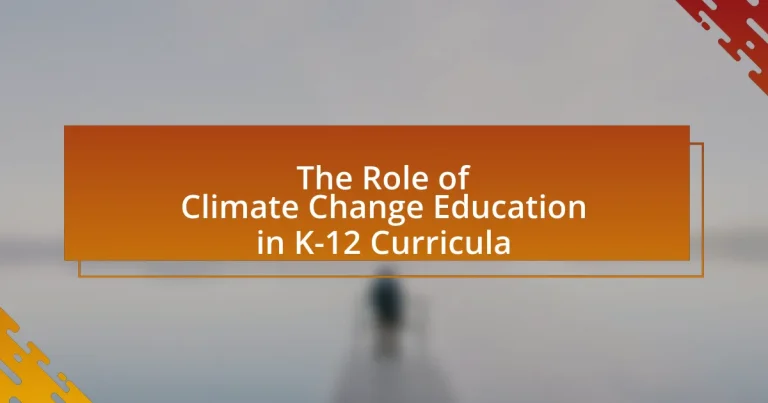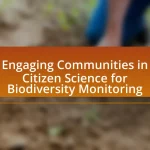Climate change education in K-12 curricula is essential for fostering environmental awareness and understanding among students. This education equips learners with knowledge about the causes and effects of climate change, promoting critical thinking and informed decision-making. Key concepts such as the greenhouse effect, carbon footprint, and mitigation strategies are crucial for developing responsible future citizens. The article explores the importance of integrating climate change topics into various subjects, current trends in education, challenges faced in implementation, and the role of technology and community partnerships in enhancing climate literacy. Additionally, it discusses effective teaching practices and the impact of climate change education on student behavior and awareness.
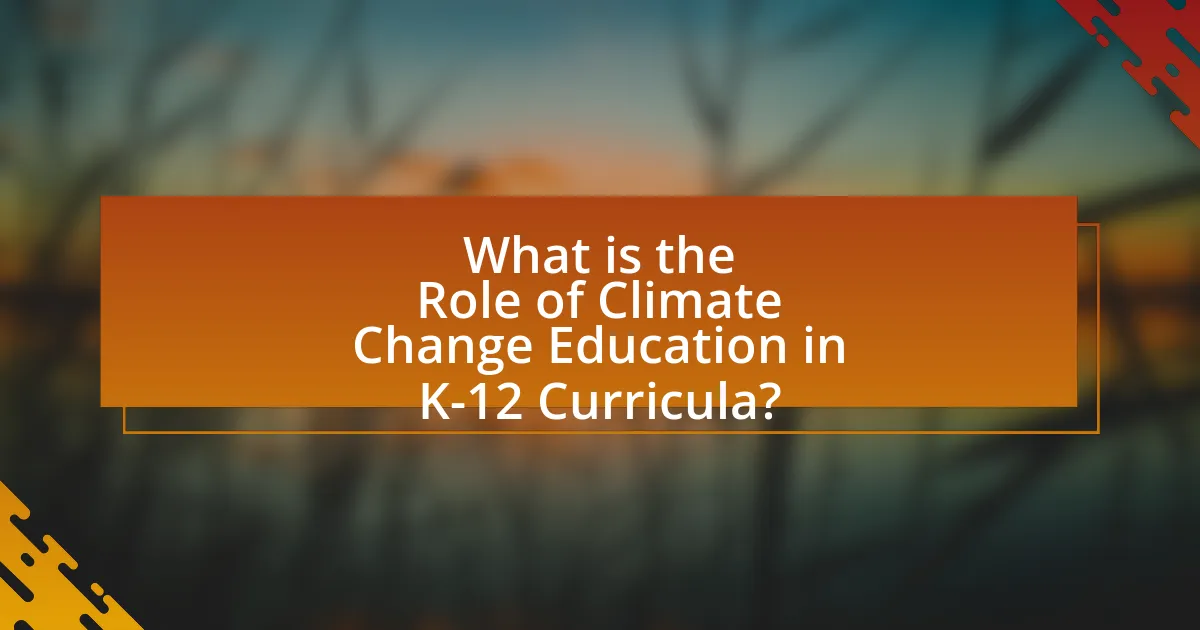
What is the Role of Climate Change Education in K-12 Curricula?
Climate change education in K-12 curricula plays a crucial role in fostering awareness and understanding of environmental issues among students. This education equips students with the knowledge to recognize the causes and effects of climate change, promoting critical thinking and informed decision-making. Research indicates that integrating climate change topics into subjects like science, social studies, and geography enhances students’ engagement and encourages proactive behaviors towards sustainability. For instance, a study by the National Center for Science Education found that students exposed to climate change education are more likely to support policies aimed at reducing carbon emissions. Thus, climate change education is essential for preparing future generations to address environmental challenges effectively.
Why is Climate Change Education important for K-12 students?
Climate Change Education is important for K-12 students because it equips them with the knowledge and skills necessary to understand and address the challenges posed by climate change. This education fosters critical thinking and encourages students to engage in sustainable practices, which are essential for their future and the health of the planet. Research indicates that early exposure to climate science can lead to increased environmental awareness and proactive behaviors; for instance, a study published in the journal “Environmental Education Research” found that students who received climate change education were more likely to participate in environmental initiatives. Thus, integrating climate change education into K-12 curricula is vital for preparing informed and responsible future citizens.
What are the key concepts of climate change that should be taught?
The key concepts of climate change that should be taught include the greenhouse effect, carbon footprint, climate systems, impacts of climate change, and mitigation strategies. The greenhouse effect describes how greenhouse gases trap heat in the atmosphere, leading to global warming. Understanding carbon footprint emphasizes the total greenhouse gas emissions caused by human activities, which is crucial for promoting sustainable practices. Climate systems encompass the interactions between the atmosphere, oceans, land, and living organisms, highlighting the complexity of climate dynamics. The impacts of climate change, such as rising sea levels, extreme weather events, and biodiversity loss, illustrate the urgent need for action. Finally, mitigation strategies, including renewable energy adoption and conservation efforts, provide practical solutions to reduce climate change effects. These concepts are supported by scientific consensus, as outlined in reports from the Intergovernmental Panel on Climate Change (IPCC), which emphasize the importance of education in fostering informed and responsible global citizens.
How does climate change education impact student awareness and behavior?
Climate change education significantly enhances student awareness and behavior regarding environmental issues. Research indicates that students exposed to climate change curricula demonstrate increased knowledge about climate science, its impacts, and the importance of sustainability practices. For instance, a study published in the journal “Environmental Education Research” found that students who participated in climate change education programs showed a 30% increase in their understanding of climate-related concepts compared to those who did not receive such education. This heightened awareness often translates into proactive behaviors, such as increased participation in environmental initiatives and advocacy for sustainable practices within their communities.
What are the current trends in Climate Change Education within K-12 curricula?
Current trends in Climate Change Education within K-12 curricula emphasize interdisciplinary approaches, integration of local environmental issues, and the use of technology for enhanced learning experiences. Schools are increasingly adopting project-based learning that encourages students to engage with real-world climate challenges, fostering critical thinking and problem-solving skills. Research indicates that curricula incorporating hands-on activities and community involvement lead to higher student engagement and understanding of climate science. For example, the National Oceanic and Atmospheric Administration (NOAA) has developed resources that support educators in implementing climate education effectively, highlighting the importance of local context in teaching climate change.
How are different states integrating climate change into their educational standards?
Different states are integrating climate change into their educational standards by incorporating it into science curricula, promoting interdisciplinary approaches, and aligning with national frameworks. For instance, California’s Next Generation Science Standards explicitly include climate change topics, requiring students to understand its causes and impacts. Similarly, New Jersey’s Student Learning Standards for Science mandate the inclusion of climate change education, emphasizing its relevance to environmental science. Furthermore, states like Massachusetts and New York have developed specific guidelines that encourage educators to address climate change across various subjects, ensuring a comprehensive understanding among students. These efforts reflect a growing recognition of the importance of climate literacy in preparing students for future challenges.
What resources are available for teachers to implement climate change education?
Teachers can access a variety of resources to implement climate change education, including curriculum guides, online platforms, and professional development programs. Notable resources include the National Oceanic and Atmospheric Administration (NOAA) Climate.gov, which offers lesson plans and data sets, and the Climate Literacy and Energy Awareness Network (CLEAN), providing vetted educational materials. Additionally, organizations like the National Science Teachers Association (NSTA) offer professional development workshops focused on climate science. These resources are designed to enhance teachers’ understanding and ability to convey climate change concepts effectively in K-12 curricula.
What challenges exist in implementing Climate Change Education in K-12 schools?
Implementing Climate Change Education in K-12 schools faces several challenges, including curriculum integration, teacher training, and resource availability. Curriculum integration is difficult because existing educational frameworks often lack flexibility to incorporate new, interdisciplinary topics like climate change. Teacher training presents a challenge as many educators may not feel adequately prepared or knowledgeable to teach complex climate science concepts. Additionally, resource availability is a significant barrier, as schools may lack access to up-to-date materials, technology, and funding necessary to support effective climate change education. These challenges hinder the ability to provide comprehensive and impactful climate change education in K-12 settings.
What are the common misconceptions about climate change among students?
Common misconceptions about climate change among students include the belief that climate change is a natural occurrence rather than primarily driven by human activities. Many students think that climate change will not affect them personally or that its impacts are far in the future. Additionally, some students underestimate the severity of climate change, believing it to be a minor issue compared to other global challenges. Research indicates that these misconceptions can hinder effective climate change education and awareness, as studies show that understanding the human impact on climate is crucial for fostering responsible behavior and engagement in climate action.
How can educators overcome resistance to climate change topics?
Educators can overcome resistance to climate change topics by integrating local environmental issues into the curriculum, making the content relevant and relatable to students. This approach fosters engagement and personal connection, as students can see the direct impact of climate change in their own communities. Research indicates that when students learn about climate change through the lens of local events or phenomena, they are more likely to understand and accept the information presented. For instance, a study published in the Journal of Environmental Education found that place-based education significantly increased students’ knowledge and concern about climate issues. By utilizing local examples, educators can effectively reduce resistance and promote a deeper understanding of climate change.
How does Climate Change Education connect to broader educational goals?
Climate Change Education connects to broader educational goals by fostering critical thinking, promoting environmental literacy, and encouraging civic engagement among students. This educational approach aligns with the goals of developing informed citizens who can address complex global challenges. For instance, the Next Generation Science Standards emphasize the importance of understanding climate systems and human impacts, which enhances students’ scientific inquiry skills and their ability to analyze data. Furthermore, integrating climate change topics into curricula supports interdisciplinary learning, linking science, social studies, and ethics, thereby preparing students to make informed decisions and take action in their communities.
What role do parents and communities play in supporting Climate Change Education?
Parents and communities play a crucial role in supporting Climate Change Education by fostering awareness and engagement among students. Parents can reinforce climate education at home by discussing environmental issues, encouraging sustainable practices, and participating in school activities related to climate change. Communities contribute by providing resources, organizing local initiatives, and creating partnerships with schools to enhance educational programs. Research indicates that when parents are involved in their children’s education, students demonstrate higher academic achievement and increased motivation, which is particularly relevant in subjects like climate science. Additionally, community-led projects, such as tree planting or recycling programs, serve as practical applications of climate education, reinforcing the concepts learned in the classroom.
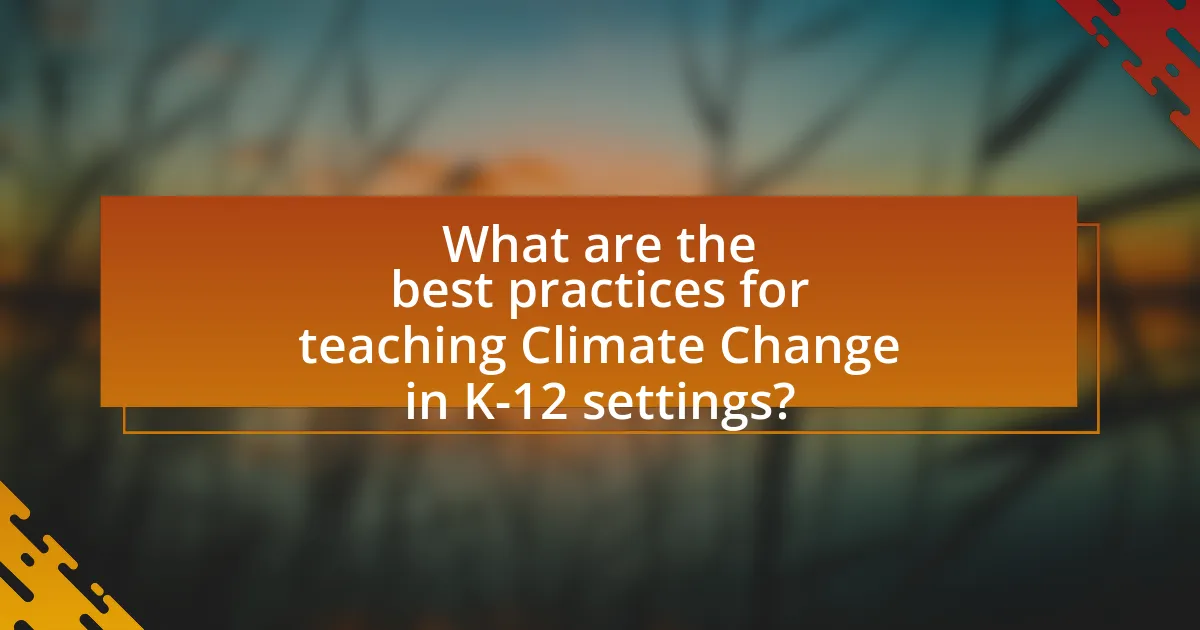
What are the best practices for teaching Climate Change in K-12 settings?
The best practices for teaching Climate Change in K-12 settings include integrating interdisciplinary approaches, utilizing hands-on activities, and fostering critical thinking. Interdisciplinary approaches allow students to understand climate change through various subjects such as science, geography, and social studies, enhancing their overall comprehension. Hands-on activities, such as experiments and projects, engage students actively, making the learning experience more impactful. Fostering critical thinking encourages students to analyze data, evaluate sources, and develop their own informed opinions about climate change. Research indicates that students who engage in these practices demonstrate a deeper understanding of climate issues and are more likely to take action in their communities.
How can educators effectively engage students in climate change discussions?
Educators can effectively engage students in climate change discussions by incorporating interactive and experiential learning methods. These methods include hands-on projects, simulations, and real-world problem-solving activities that allow students to explore climate issues actively. Research indicates that students retain information better and develop critical thinking skills when they participate in experiential learning (National Research Council, 2012). Additionally, integrating technology, such as virtual reality and online platforms for collaboration, can enhance engagement by providing immersive experiences that connect students with global climate challenges.
What interactive methods can be used to teach climate change concepts?
Interactive methods to teach climate change concepts include simulations, role-playing, and hands-on experiments. Simulations allow students to model climate systems and observe the impacts of various factors on climate change, enhancing their understanding through experiential learning. Role-playing activities enable students to assume different perspectives, such as policymakers or environmental activists, fostering empathy and critical thinking about climate issues. Hands-on experiments, such as measuring carbon footprints or conducting local environmental assessments, provide tangible experiences that reinforce theoretical knowledge. These methods have been shown to increase student engagement and retention of climate change concepts, as evidenced by studies indicating that active learning strategies significantly improve comprehension and interest in environmental science topics.
How can project-based learning enhance understanding of climate change?
Project-based learning enhances understanding of climate change by engaging students in real-world problems, fostering critical thinking and collaboration. This hands-on approach allows students to investigate climate-related issues, such as local environmental impacts, through research and practical applications. For instance, a study by the National Research Council highlights that project-based learning can improve students’ ability to apply scientific concepts to real-life situations, thereby deepening their comprehension of climate change dynamics. By working on projects that require data collection, analysis, and presentation, students not only learn about climate change but also develop skills necessary for addressing complex environmental challenges.
What assessments can be used to measure student understanding of climate change?
Formative assessments, such as quizzes, concept maps, and reflective journals, can effectively measure student understanding of climate change. These assessments allow educators to gauge students’ grasp of key concepts, such as greenhouse gas effects and climate systems. Research indicates that formative assessments enhance learning by providing immediate feedback, which is crucial for understanding complex topics like climate change (Black & Wiliam, 1998). Additionally, project-based assessments, where students engage in real-world problem-solving related to climate issues, further demonstrate their comprehension and application of climate change knowledge.
How can formative assessments inform teaching strategies in climate change education?
Formative assessments can inform teaching strategies in climate change education by providing real-time feedback on student understanding and engagement. These assessments, such as quizzes, discussions, and reflective journals, allow educators to identify misconceptions and adjust their instructional approaches accordingly. For instance, a study by Black and Wiliam (1998) found that formative assessment significantly enhances student learning outcomes by tailoring teaching methods to meet students’ needs. By analyzing student responses, teachers can modify lesson plans, incorporate relevant examples, and foster a more interactive learning environment that addresses specific climate change concepts effectively.
What role do standardized tests play in evaluating climate change knowledge?
Standardized tests serve as a tool for assessing students’ understanding of climate change concepts within K-12 curricula. These assessments can measure knowledge retention, comprehension of climate science, and the ability to apply this knowledge to real-world scenarios. For instance, standardized tests often include questions that evaluate students’ grasp of climate change causes, effects, and mitigation strategies, thereby providing educators with data on student learning outcomes. Research indicates that standardized assessments can highlight gaps in climate change education, guiding curriculum improvements and instructional strategies to enhance student engagement and understanding of this critical issue.
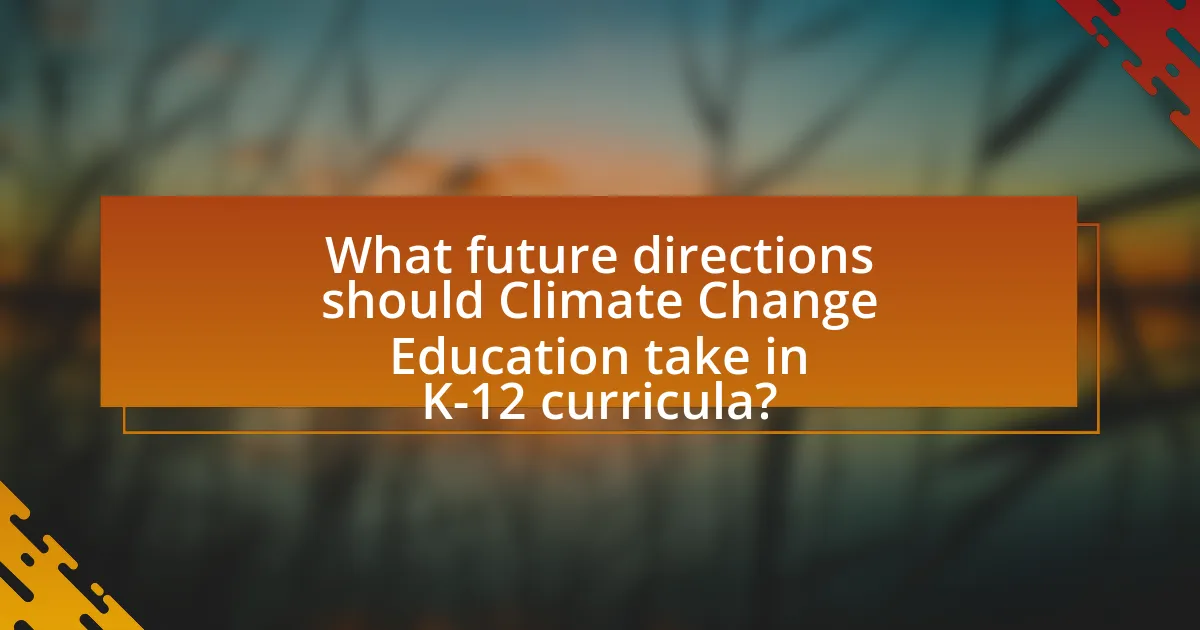
What future directions should Climate Change Education take in K-12 curricula?
Future directions for Climate Change Education in K-12 curricula should focus on integrating interdisciplinary approaches that combine science, social studies, and ethics. This integration allows students to understand the multifaceted impacts of climate change on ecosystems, economies, and communities. Research indicates that interdisciplinary education enhances critical thinking and problem-solving skills, essential for addressing complex global issues like climate change. For instance, a study by the National Academies of Sciences, Engineering, and Medicine emphasizes the importance of teaching climate change through a systems-thinking lens, which fosters a comprehensive understanding of the subject. Additionally, curricula should incorporate hands-on, project-based learning experiences that engage students in local climate issues, promoting active citizenship and community involvement. This approach not only makes learning relevant but also empowers students to take action in their communities.
How can technology enhance Climate Change Education in schools?
Technology can enhance Climate Change Education in schools by providing interactive learning experiences and access to real-time data. For instance, digital platforms and simulations allow students to visualize climate models and understand complex environmental systems, making abstract concepts more tangible. Research indicates that using technology in education can improve engagement and retention; a study by the National Education Association found that technology integration can lead to a 30% increase in student motivation. Additionally, online resources and educational apps enable students to explore climate change impacts globally, fostering a sense of global citizenship and responsibility.
What digital tools are available for teaching climate change concepts?
Digital tools available for teaching climate change concepts include interactive simulations, educational games, and online platforms. For instance, platforms like NASA’s Climate Kids provide engaging resources that explain climate science through games and activities. Additionally, tools such as Google Earth allow students to visualize climate change impacts through satellite imagery and data overlays. Research indicates that using these digital tools enhances student engagement and understanding of complex climate issues, making them effective for K-12 education.
How can virtual learning environments support climate change education?
Virtual learning environments can support climate change education by providing interactive and accessible platforms for students to engage with climate science and sustainability topics. These environments facilitate real-time collaboration, enabling students to participate in simulations, access diverse resources, and connect with experts globally. Research indicates that students in virtual settings demonstrate improved understanding of complex climate concepts, as they can visualize data and engage in problem-solving activities. For instance, a study by the National Oceanic and Atmospheric Administration found that students using online simulations showed a 30% increase in their ability to apply climate knowledge to real-world scenarios. This evidence underscores the effectiveness of virtual learning environments in enhancing climate change education.
What collaborative efforts can improve Climate Change Education across districts?
Collaborative efforts that can improve Climate Change Education across districts include the establishment of inter-district partnerships, shared resources, and joint professional development programs for educators. Inter-district partnerships enable the sharing of best practices and curriculum resources, which can enhance the quality and consistency of climate change education. For instance, districts can collaborate on developing standardized lesson plans and assessment tools that align with state and national standards. Additionally, joint professional development programs allow teachers to learn from experts and each other, fostering a community of practice that emphasizes effective teaching strategies in climate change education. Research indicates that collaborative professional development can lead to improved teacher efficacy and student outcomes, as seen in studies conducted by the National Science Foundation, which highlight the positive impact of collaborative learning environments on educational effectiveness.
How can partnerships with environmental organizations benefit K-12 education?
Partnerships with environmental organizations can enhance K-12 education by providing students with access to real-world environmental issues and solutions. These collaborations often lead to hands-on learning experiences, such as field trips, workshops, and projects that engage students in environmental stewardship. For instance, a study by the National Environmental Education Foundation found that students involved in environmental education programs showed a 20% increase in their understanding of ecological concepts. Additionally, partnerships can supply educators with resources, training, and curriculum materials that align with current environmental science standards, thereby enriching the educational experience and fostering a sense of responsibility towards the environment among students.
What role do teacher training programs play in enhancing climate change education?
Teacher training programs play a crucial role in enhancing climate change education by equipping educators with the knowledge and skills necessary to effectively teach this complex subject. These programs provide teachers with updated content on climate science, pedagogical strategies, and resources that foster critical thinking and engagement among students. Research indicates that teachers who receive specialized training in climate change are more confident in their ability to teach the topic, leading to improved student understanding and awareness. For instance, a study published in the Journal of Environmental Education Research found that teachers who participated in climate change professional development programs significantly increased their students’ knowledge and concern about climate issues.
What practical tips can educators use to implement Climate Change Education effectively?
Educators can implement Climate Change Education effectively by integrating interdisciplinary approaches that connect climate science with local environmental issues. This method encourages students to engage with real-world problems, fostering critical thinking and problem-solving skills. For instance, incorporating project-based learning allows students to investigate local climate impacts, such as flooding or heatwaves, which can be supported by data from the National Oceanic and Atmospheric Administration (NOAA) that highlights regional climate trends. Additionally, utilizing interactive resources, such as simulations and digital platforms, can enhance student understanding and retention of complex climate concepts. Research from the National Center for Climate Education indicates that hands-on activities significantly improve student engagement and comprehension in climate-related topics.
